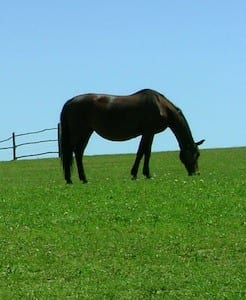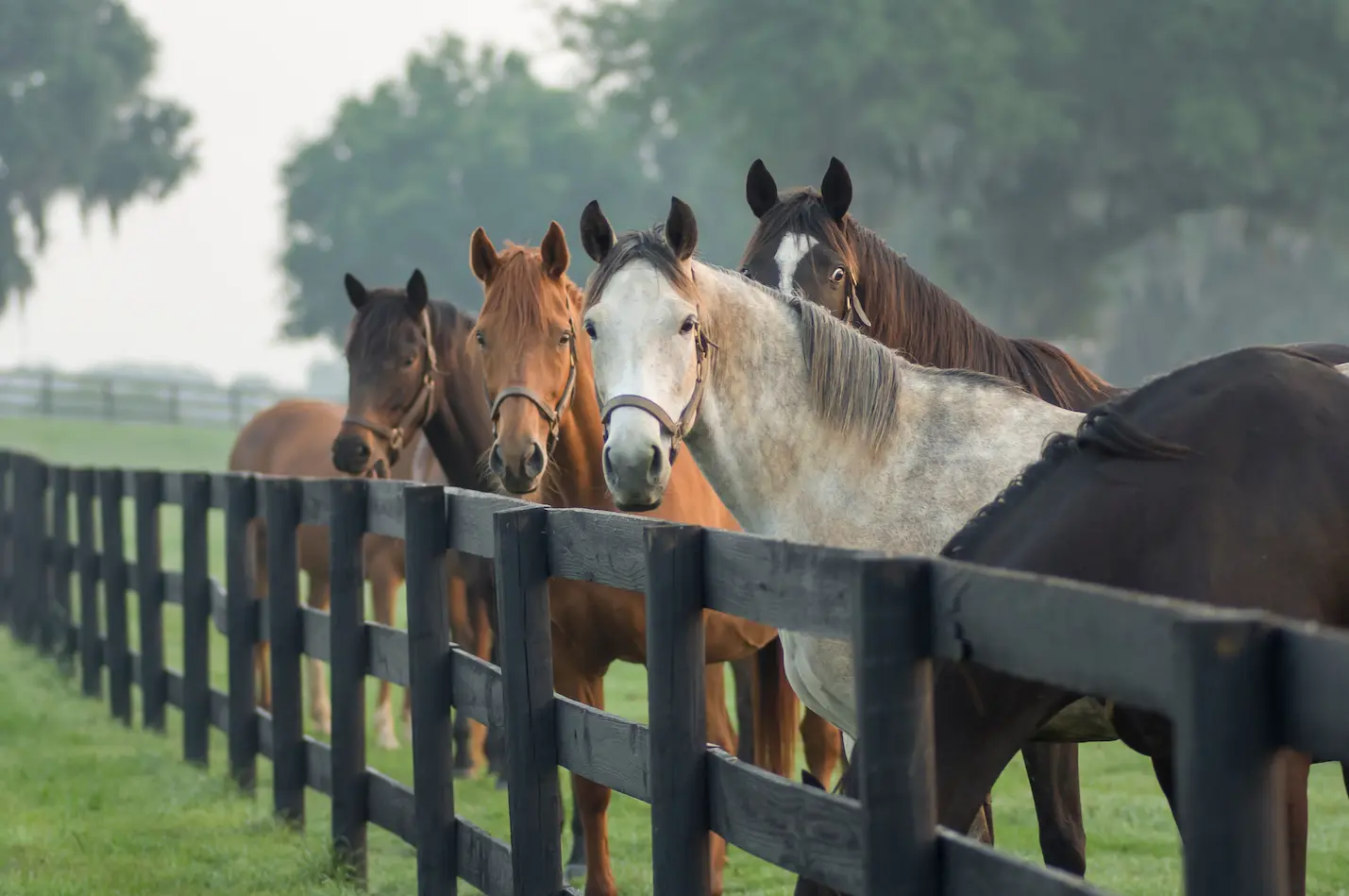
This crazy wet weather across much of the country is wreaking havoc on our attempts to acclimate our horses at Freedom Farm to the lush spring grass. As a result it’s taking longer than normal to increase their turnout time and so spring grass management is still in full swing even at the end of May.
But why is it so critical to closely manage our horse’s time out on grass in spring?
The answer is simple: new spring grass is typically high in particular nutrients called fructans – to which your horse’s digestive tract is unaccustomed after a long winter on hay and which can be hard on the hindgut. As a result, the equine digestive system needs to be slowly conditioned to handle hours of grazing green pasture grass.
What Are Fructans In Grass?
“Fructans” in grass are fructose chain molecules, a type of sugar. This sugar is a byproduct of photosynthesis and is used to aid plant growth. On sunny days, fructose is produced in large quantities and stored within the blade of grass. When it cools off at night, these fructans are then utilized as fuel for growth.
Fructans are higher in the seasons when the weather is cool: spring and fall. They are still present during hot summers, but not usually at levels that can be dangerous.
Here are a few key things you should know about fructan levels:
- Higher in stressed pastures than in lush grass
- Higher when night-time temperatures drop below 40 degrees (because the grasses do not grow, so the excess remains stored in the stems)
- Lower in new spring grass (first 3-6 inches), but also lower in fiber
- High in mature grass (8-10 inches), but also higher in fiber
- Lower in the morning when days are sunny and nights warm
- Higher in the afternoon/evening on a sunny day
- Lower in rainy, wet weather
How Do Fructans Affect Horses?
Because fructans are a non-structural carbohydrate, horses cannot digest them. Therefore, fructans must be broken down by the microorganisms in the equine hindgut first so that they can be absorbed. Because they are a type of sugar, horses love to eat grasses that are high in fructans.
Horses that are unaccustomed to grass turnout, that have been on hay all winter, or that are already prone to colic and laminitis can have their digestive tracts upset easily by high levels of fructans. Here’s how it works:
- The types of microorganisms in a horse’s hindgut vary according to the types of food it eats. When a horse is suddenly put out on pasture after a winter of hay, the microorganisms aren’t equipped to digest the high levels of fructans, and the bacteria die.
- When the good bacteria dies off, the acidity of the hindgut is raised (lactic acid is produced) and harmful pathogens are released.
- The lactic acid and pathogens are absorbed into the bloodstream and are known causes of laminitis.
- When the acidity level of the hindgut increases quickly as it is prone to do when fructans are high, the horse can also colic.
While some horses have a higher risk for colic and laminitis, they are very serious conditions that can affect any horse if it isn’t managed carefully.
Spring Grass Management Tips to Avoid Health Risks
Fortunately, careful management in feeding and turnout can help protect your horse from health risks like laminitis and colic caused by high levels of fructans in grass. The key is to build up time on grass slowly.
Increase Spring Turnout Gradually
For all horses that have subsisted on hay all winter, introduce pasture time incrementally over a period of weeks. At Freedom Farm, we start our horses on grass for an hour a day, and then increase that time by 15-30 minutes each subsequent day. If the weather is bad and we have to skip a day of turnout, we keep the horses at the same amount of time the next time they go out.
Horses with a higher tolerance may be able to start out with a longer time initially, while horses particularly prone to issues may need to start at less.
Alternatively, if you have a horse that lives out 24-7 it is prudent to bring it in off grass for part of the day when grass is newly growing and fructan levels are high.
Avoid Afternoon Grasses
Because fructan levels reach their highest in the afternoon on sunny days, it’s best to turnout in the morning or late at night.
Maintain Pastures
Fructans levels are higher in pastures that are overgrazed or where grass is too mature. Rotate pastures to give them a break, and keep them mowed to 4-8 inches.
 This crazy wet weather across much of the country is wreaking havoc on our attempts to acclimate our horses at Freedom Farm to the lush spring grass. As a result it’s taking longer than normal to increase their turnout time and so spring grass management is still in full swing even at the end of May.
But why is it so critical to closely manage our horse’s time out on grass in spring?
The answer is simple: new spring grass is typically high in particular nutrients called fructans – to which your horse’s digestive tract is unaccustomed after a long winter on hay and which can be hard on the hindgut. As a result, the equine digestive system needs to be slowly conditioned to handle hours of grazing green pasture grass.
This crazy wet weather across much of the country is wreaking havoc on our attempts to acclimate our horses at Freedom Farm to the lush spring grass. As a result it’s taking longer than normal to increase their turnout time and so spring grass management is still in full swing even at the end of May.
But why is it so critical to closely manage our horse’s time out on grass in spring?
The answer is simple: new spring grass is typically high in particular nutrients called fructans – to which your horse’s digestive tract is unaccustomed after a long winter on hay and which can be hard on the hindgut. As a result, the equine digestive system needs to be slowly conditioned to handle hours of grazing green pasture grass.



